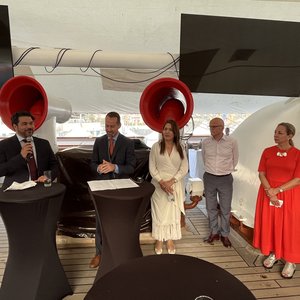USA - Federal Funding Opportunity for alternative feed sources available
A Federal Funding Opportunity (FFO) is available under the Saltonstall-Kennedy Grant Program. Funding for potential projects is contingent upon the availability of Fiscal Year 2010 appropriations. Applications are due September 1, 2009.
The Saltonstall-Kennedy Act established a fund (known as the S-K fund) that the Secretary of Commerce uses to provide grants or cooperative agreements for fisheries research and development projects addressed to any aspect of U.S. commercial and recreational fisheries. The objective of the S-K Grant Program is to address the needs of fishing communities (as defined by the Magnuson-Stevens Act) in optimizing economic benefits within the context of rebuilding and maintaining sustainable fisheries, and in dealing with the impacts of conservation and management measures. Eligible applicants are invited to apply for potential Fiscal Year 2010 SK grant funding.
Eligibility
Institutions of higher education, nonprofit organizations, commercial organizations, State, local and Indian tribal governments, and individuals are eligible to apply for a grant or a cooperative agreement under the S-K Grant Program. You are not eligible to submit an application under this program if you are an employee of any Federal agency; are a Fishery Management Council (Council); or are an employee of a Council. However Council members who are not Federal employees can submit an application to the S-K Program, as an individual.
Grant Program Focus
Funding priorities reflect NOAA's goal to conserve, protect, manage, and restore living marine resources and coastal and ocean resources critical to public health and vitality to the U.S.economy. During Fiscal Year 2010, S-K project priorities focus on Aquaculture, Optimum Utilization of Harvested Resources under Federal or State Management, Fisheries Socioeconomics, and Conservation Engineering investigations:
Aquaculture - Projects which demonstrate the feasibility of culturing marine fish species identified as potential or suitable candidates for aquaculture (eg. redfish, pompano, cod, halibut, sablefish, mussels, scallops, milkfish, and other baitfish species, and tuna). Projects should include where feasible, participation of the traditional fishing communities. Projects which explore alternate feed sources that reduce the demand for marine protein in aquaculture feeds such as use of fish processing trimmings in aquaculture feeds. Projects which investigate alternative ways to minimize interactions with marine mammals and other living marine resources.
Optimum Utilization of Harvested Resources under Federal or State Management - Reduce or eliminate factors such as diseases, human health hazards, and quality problems that limit the utilization of fish and their products in the United States and abroad through cooperative research with fishing industry participation. Increase public knowledge of safe handling and use of fish and their products. Develop seafood fraud detection and reduction techniques. Develop usable products from economic discards (defined in the Magnuson-Stevens Act as fish which are the target of a fishery, but are not retained because they are of an undesirable size, sex, or quality, or for other economic reasons”) and byproducts of processing. Facilitate industry (including restaurants and seafood marketing facilities, etc.) cooperation and outreach to promote and enhance marketability of regional U.S. fishery products. Collect data on population dynamics, life histories, etc., of fish not currently under Federal FMPs, for the Councils to determine the feasibility of a new federally managed fishery that could provide additional fishing opportunity.
Fisheries Socioeconomics - Improve the understanding of the socioeconomic aspects of fisheries to increase the knowledge base for making decisions that affect commercial, recreational, and subsistence fishing. Examples could include, but are not limited to ethnographic baseline data on specific fishing communities; cost-income data; analyses of the socioeconomic impacts of specific management measures in certain fisheries; analysis of factors influencing demand for recreational fishing trips by anglers; and market analyses to determine factors that influence demand and supply of specific products, including imports.
Conservation Engineering - Reduce or eliminate adverse interactions between fishing operations and non-targeted, protected, or prohibited species, including the inadvertent take, capture, or destruction of such species. These include juvenile or sublegal-sized fish and shellfish, females of certain crabs, fish listed under the Endangered Species Act (ESA), marine turtles, seabirds, or marine mammals. Improve the survivability of fish discarded or intentionally released and of protected species released in fishing operations. Reduce or eliminate impacts of fishing activity on essential fish habitat (EFH) that adversely affect the sustainability of the fishery. Activities could focus on the development of gear technologies and/or changes to fishing practices to reduce the bycatch of sea turtles in bottom otter trawl or gillnet gear; development or improvement of existing gear modification designed to reduce incidental interactions between fishing gear (eg. traps/pots, gillnets, and trawls) and marine mammals, including studies to investigate new gear which could effectively reduce serious injury and mortality of right whales and other large whales in the U.S. Atlantic commercial fixed gear fisheries and through the development of entanglement mitigation gear. Projects that aid in the understanding and integration of all the interactions that a target fish stock has with predators, competitors, and prey species; other ocean uses eg. energy projects that can prohibit/inhibit fishing biology and ecology; the complex interactions between fisheries and their habitat; the effects of fishing on fish stocks and their habitat, or improve the seafood industry’s use of the ecosystem.
Cost Sharing/Matching Requirement
Cost sharing is required in order to leverage the limited funds available for this program and to encourage partnerships among government, industry, and academia to address the needs of fishing communities. The minimum cost share of 10 percent of total project costs is required with the maximum not to exceed 50 percent of total project costs.
Note: NOAA advertises all of its funding opportunities through "Find Grant Opportunities" on the Grants.Gov website. This site is searchable and contains summary information on all federal funding opportunities with a link to the full announcement. Users can search announcements by topic, funding agency, and date, as well as subscribing to an e-mail notification service based on these parameters.
To view the full announcement, including specifics on eligibility, access to application forms, and the process for submitting proposals, go to: http://www.grants.gov/search/basic.do, and use the following FFO #: NOAA-NMFS-FHQ-2010-2002039.










